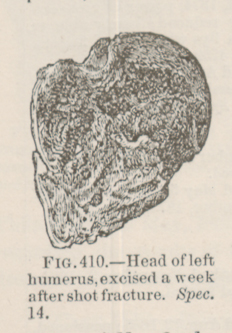Title: P.——, J.
Source text: The Medical and Surgical History of the War of the Rebellion. (1861-65.), Part 2, Volume 2 (Washington, DC: Government Printing Office, 1876), 540.
Civil War Washington ID: med.d2e31416
TEI/XML: med.d2e31416.xml
CASE 1511.—Sergeant J. P.——, Co. C, 4th Michigan, was wounded at Malvern Hill, July 1, 1862. He was sent to Washington, and entered Cliffburne Hospital. Assistant Surgeon J. S. Billings, U. S. A., reported: "Gunshot wound of the left shoulder. The ball entered over the coracoid process of the scapula, passed in a horizontal line outward and a little backward, and emerged, after splintering the head of the humerus. At the date of his admission, there was very little swelling of the part, slight discharge, and no constitutional symptoms. The patient could move the arm without difficulty or pain, and absolutely refused to have any operation performed. After ten days had elapsed, suppuration having greatly increased, the arm became brawny and œdematous, and hectic supervened. A probe was introduced; and the patient, having been informed that he would certainly die if the operation of excision of the head of the humerus were not resorted to, consented to have it done. On the afternoon of the same day, a semi-circular incision was made from the posterior edge of the wound to within an inch of the interior. The integument having been laid back, the furrow made by the ball and spicula detached in its passage were seen. Forcing the head of the bone out of the cavity, Dr. Billings removed it with the saw, just below the tuberosities. There was slight hæmorrhage from the deep-seated vessels, which were retracted beneath the capsule in such a way as to prevent their being twisted. The wound was left unclosed, stuffed with lint, and dressed with cold water. No recurrence of the bleeding took place during the night, but upon the removal of the charpie in the morning, there was a slight hæmorrhage, easily stopped by the persulphate of iron. The brawny feel had disappeared, together with the pain and œdema. From this period, until three days before his death, July 21st, the patient remained without any change of consequence taking place. Under the influence of the treatment adopted, he retained his strength to all appearance, and the power of his faculties. Suddenly, however, the edges of the wound broke down, its odor became very offensive, and subsultus and hectic supervened. Successive rigors, increasing in violence, set in, with short intermissions, and the patient rapidly succumbed. The autopsy disclosed no derangement of the viscera; no disease of the heart and lungs. The periosteum was not stripped off the bone of the wounded limb, but the brachial and cephalic veins opposite to the seat of the injury were thickened very much, and the axillary up to within an inch of the clavicle. One sinus, not of a metastatic character, was revealed, extending from the axilla along the upper third of the humerus. The patient died in the first stage of pyæmia." The specimen (FIG. 410) was one of the earlier contributions to the Museum (Cat. Army Med. Mus., 1863, p. 9), and is represented in the adjacent wood-cut. It has been described (Cat. Surg. Sect., 1866, p. 93) as: "The head of the left humerus, excised at the surgical neck after fracture by a conoidal bullet at the greater tuberosity, which, with the inner part of the anatomical neck, is carried away."
